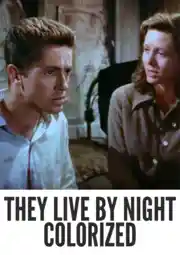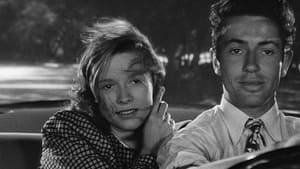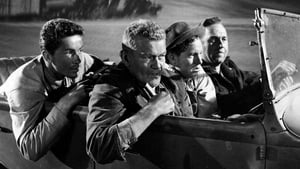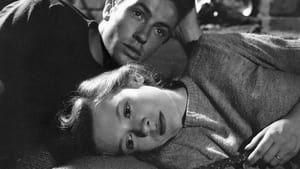Contact: [email protected]
Video Sources 0 Views
- Watch trailer
- They Live by Night Colorized


Synopsis
[ez-toc]




Introduction
Embarking on a chromatic journey into the heart of noir romance, “They Live by Night Colorized 1949” invites audiences to rediscover the timeless allure of a classic film. This article delves into the making of the 1949 noir masterpiece, exploring the nuances of its original creation and the transformative impact of colorization. Join us as we unravel the threads of the narrative, dissect the performances, assess critical reviews, and navigate the broader implications of introducing color to this cinematic gem.
The Making of “They Live by Night Colorized”
A Noir Romance Unveiled
“They Live by Night Colorized,” directed by Nicholas Ray, unfolds as a poignant tale of love and crime. Released in 1949, the film stars Farley Granger as Bowie Bowers and Cathy O’Donnell as Keechie Mobley, two young lovers on the run from the law. The narrative, adapted from Edward Anderson’s novel “Thieves Like Us,” weaves a tragic yet compelling story that captivates audiences with its raw emotion and unfiltered portrayal of romance amidst adversity.
Nicholas Ray, known for his ability to infuse authenticity into his characters, masterfully navigates the delicate balance between crime and romance. The film’s stark portrayal of the criminal underworld, coupled with the tender moments shared by the protagonists, sets “They Live by Night Colorized” apart as a noir film that transcends the boundaries of its genre.
Exploring the Colorization Process
The decision to colorize “They Live by Night Colorized” opens a Pandora’s box of possibilities and challenges. Colorization specialists, armed with historical context and an appreciation for the era’s aesthetics, embark on a journey to recreate the palette of the late 1940s. This meticulous process involves studying fashion, set design, and cultural nuances to ensure an authentic representation of the film’s original context.
Colorizing a film shot in black and white requires a delicate dance between artistry and technological precision. The original lighting, designed for monochromatic cinematography, poses challenges in replicating the intended mood and atmosphere. However, advancements in technology, coupled with the expertise of colorization specialists, allow for a nuanced and vibrant reimagination of this classic noir.
The controversy surrounding color restoration often centers on concerns about altering the filmmaker’s original intent. “They Live by Night Colorized 1949” emerges as a compelling case study, reigniting debates about the impact of colorization on the authenticity and visual appeal of beloved classics.
The Significance of Visuals in Noir Romance
Film noir, a genre often associated with shadows, intrigue, and moral ambiguity, relies heavily on visual elements to convey its narrative. “They Live by Night Colorized,” in its original black-and-white presentation, employs stark contrasts and moody lighting to accentuate the emotional depth of the characters and the unfolding drama. The colorization process introduces a new layer of complexity, offering audiences a chance to experience noir romance in a vibrant and engaging manner.
The allure of film noir lies in its ability to create an immersive experience through visuals. The play of light and shadow, the chiaroscuro lighting, and the atmospheric settings contribute to the genre’s enduring appeal. Colorization, when executed thoughtfully, enhances these elements, breathing new life into the world of “They Live by Night Colorized” and providing viewers with a fresh perspective on its noir aesthetics.
Re-Evaluation of a Cinematic Masterpiece
The critical reception of “They Live by Night Colorized” has evolved over the years, reflecting shifting perspectives on cinema and storytelling. Initially praised for its unconventional approach to the crime genre and the genuine chemistry between the leads, the film has maintained its status as a classic. As we revisit “They Live by Night Colorized” in its colorized form, there is an opportunity to reassess its impact and appreciate the nuances of the story through a different lens.
The colorized version introduces a vibrant palette to key scenes, offering a fresh and dynamic viewing experience. The performances of Farley Granger and Cathy O’Donnell, now infused with color, take on a new dimension, adding layers to the characters and their interactions. This re-evaluation prompts audiences to explore the film with a renewed sense of curiosity and engagement.
Case Study: Colorized Scenes in “They Live by Night Colorized”
Examining specific scenes from the colorized version provides insights into the effectiveness of the restoration process. The colorization of tense moments amplifies the emotional impact, with vibrant hues intensifying the psychological depth of the characters. For example, the use of color in scenes that depict the protagonists’ struggles and moments of tenderness adds a layer of visual intensity, enhancing the overall viewing experience.
However, the subjective nature of colorization is evident as not every scene benefits equally from the addition of color. Some argue that certain moments lose their original impact when stripped of their monochromatic charm, emphasizing the ongoing debate between preserving the authenticity of the past and embracing innovative reinterpretations.
Preserving Film History: The Role of Restoration Efforts
The preservation of film history is a responsibility that extends beyond mere nostalgia. “They Live by Night Colorized 1949” exemplifies the commitment to safeguarding cinematic treasures for future generations. Restoration efforts, whether through colorization, digitization, or other techniques, play a crucial role in ensuring that classic films remain accessible and relevant in a rapidly evolving landscape.
As time takes its toll on old films, the risk of losing these cultural artifacts increases. Restoration endeavors breathe new life into cinematic gems, allowing them to be experienced in formats that resonate with contemporary audiences. “They Live by Night Colorized 1949” stands as a testament to the importance of these efforts, bridging the gap between the past and the present.
The Debate Over Authenticity: Original vs. Colorized Versions
The debate over the authenticity of colorized films continues to spark discussions within the cinephile community. Purists argue that altering the original format compromises the integrity of the work, while proponents view colorization as a means to enhance accessibility and engage new audiences. “They Live by Night Colorized 1949” adds a compelling voice to this ongoing discourse.
Approaching this debate requires an appreciation for diverse perspectives. While some cherish the untouched beauty of black-and-white classics, others find value in experiencing these films in a visually updated format. The colorized version of “They Live by Night” encourages viewers to participate in this conversation, prompting reflection on how we perceive and preserve cinematic history.
Exploring the Socio-Cultural Context
Beyond the artistic and aesthetic considerations, the colorization of “They Live by Night” also provides an opportunity to delve into the socio-cultural context of the late 1940s. The era’s fashion, architecture, and societal norms come to life in vibrant hues, offering a visual time capsule for contemporary audiences. This immersive experience allows viewers to connect more deeply with the characters and their surroundings, bridging the temporal gap between then and now.
Conclusion
As we navigate the complexities of restoration, colorization, and the preservation of film history, “They Live by Night Colorized 1949” emerges as a captivating chapter in this ongoing narrative. The enduring appeal of classic films lies in their ability to transcend time and captivate audiences across generations. Whether viewed in its original black-and-white splendor or through the prism of colorization, the film remains a testament to the artistry of filmmakers who crafted stories that resonate through the ages.
In celebrating the legacy of old movies and old films, let us embrace both the authenticity of the past and the innovation of the present. “They Live by Night Colorized 1949” invites audiences to appreciate the film in its various forms, acknowledging the value of preserving cinematic history while exploring new avenues for engagement. As we continue to cherish the magic of cinema, may we honor the past and present as integral chapters in the rich tapestry of our shared cinematic heritage.
Read Media File Transfer Agreement: Terms and Conditions
Read FAQ


















